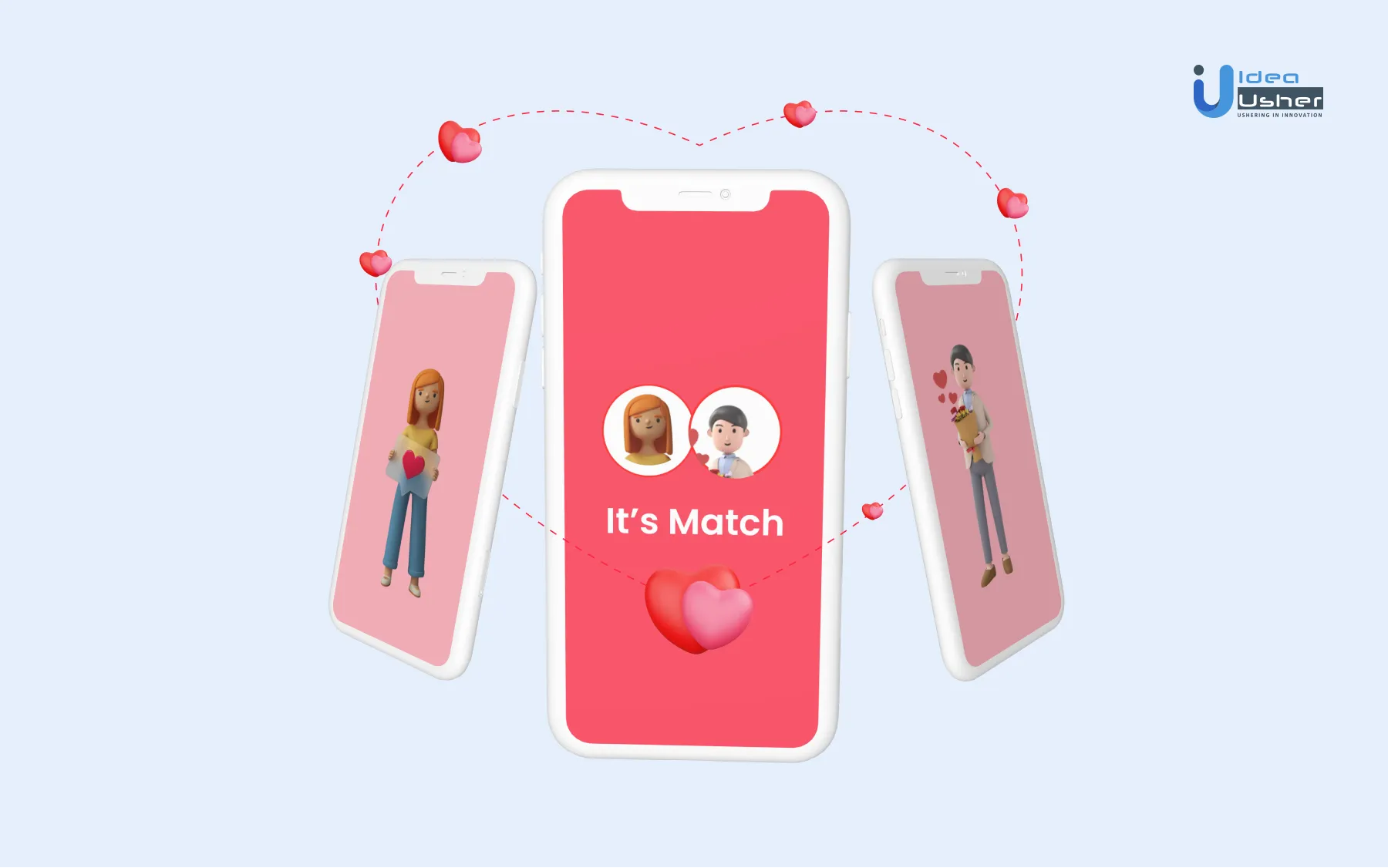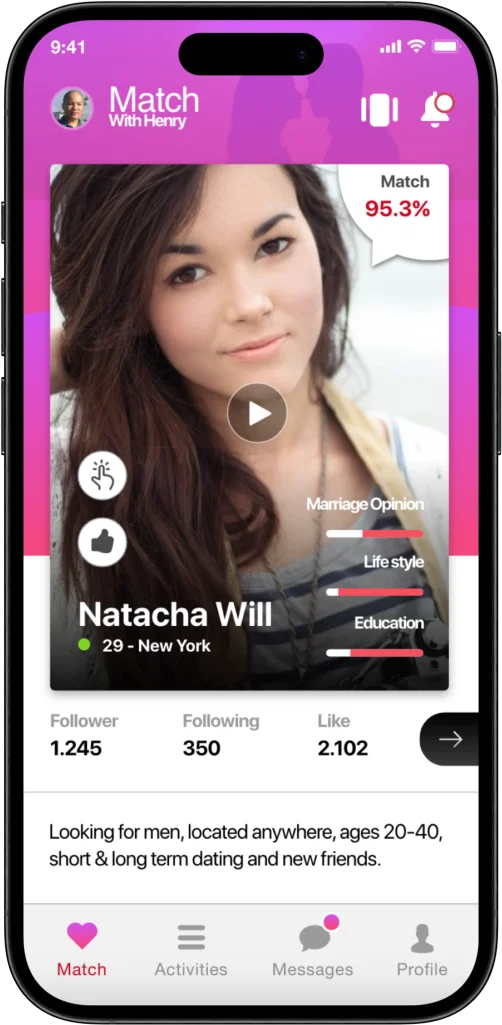Dating apps like Tinder, Bumble, and Hinge have been instrumental in expanding the market for dating platforms. Meeting potential partners in malls, parks, and restaurants is now a thing of the past. In today’s era of mobile apps, everything is accessible right at our fingertips, and so is dating. Thus, learning how to create a dating app becomes essential.
Creating a dating platform involves various factors, like researching the market, the app features, the tech stack, and more.
This blog discusses all of these factors in detail.
What is a Dating App?
Dating apps have transformed our ways of connecting with people in the quest for romantic relationships. By utilizing GPS technology and seamless mobile wallet integration, these platforms redefine the dating experience. They excel in expediting partner discovery, initiating conversations, and establishing potential real-world encounters.
Notably, online dating emerged as the primary method for new U.S. couples to meet in 2017, and projections suggest a staggering 70% online meeting rate by 2040. These apps boast diverse features; for instance, Tinder and Bumble employ a swipe-based liking system, while Hinge and Coffee Meets Bagel stimulate conversations through imaginative prompts. Embracing innovation, some platforms introduce video chats to enhance virtual interactions, allowing users to familiarize themselves before contemplating in-person meetings.
As the dating app evolves dynamically, each platform builds a distinctive user experience, shaping the future trajectory of digital romance.
How does a dating app work?
Dating apps are frequently used by people who have recently moved to a new location and are looking to meet people in their area. They are also used by those who are single and want to find someone with whom they can start a relationship.
The specific functionalities may vary, but here’s a general overview of how a dating app operates:
1. User Registration
Users download and install the app, then create an account by providing basic information, such as name, age, gender, and often, a profile picture.
2. Profile Creation
Users fill out their profiles with additional details, including interests, hobbies, and preferences. Some apps may use detailed questionnaires to gather more information.
3. Matching Algorithms
The app employs various matching mechanisms, such as location-based matching, mathematical matching (based on user-provided preferences), behavior-based matching (analyzing user activity), and machine learning algorithms. These mechanisms help suggest potential matches that align with the user’s profile.
4. Browsing Profiles
Users can browse through profiles of other users based on the provided matches or through search filters. They typically see a condensed version of the profile with key information and a profile picture.
5. Swiping or Matching
Many dating apps use a swiping mechanism. Users swipe right to express interest in a profile and left to pass. If two users mutually swipe right, indicating a mutual interest, they become a match and can start communicating.
6. Communication Features
Once matched, users can typically chat with each other through the app’s messaging system. Some apps offer additional features like voice or video calls to facilitate communication.
7. Privacy and Safety Features
Dating apps implement safety features, such as the ability to report and block users, as well as privacy settings to control the visibility of personal information.
8. Geolocation Services
Many apps use geolocation to suggest matches within a certain distance. This is especially common for apps focused on facilitating real-world meetings.
9. Feedback and Machine Learning
The app collects data on user interactions and feedback. Machine learning algorithms analyze this data to improve matching accuracy over time, providing more relevant suggestions based on user behavior and preferences.
10. Monetization Features
Dating apps may have premium features for which users can pay a subscription fee. These features could include enhanced visibility, additional filters, or other perks.
Understanding the dating apps market
Source – Grandviewsearch.com
In 2022, the global dating mobile app market was valued at $7939.2 million. It is expected to grow at a CAGR of 7.6% from 2023 to 2030. Increased use of smartphones and the internet, the growing adult population, and the COVID-19 pandemic have led to the growth in this market.
The dominant sector in the market was the subscription segment, capturing over 62% of the total revenue in 2022. This ascendancy can be attributed to the rising number of subscriptions, fueled by the additional perks offered in paid subscriptions such as ad-free experiences, limitless likes, and read receipts, among other advantages.
- Projections indicate that the subscription segment is set for a compound annual growth rate (CAGR) of 7.7% from 2023 to 2030.
- Further dissecting the subscription category, sub-segments include age, gender, and type.
- In terms of age, the subscription segment is stratified into four groups: 18-25 years, 26-34 years, 35-50 years, and those aged above 50.
- Notably, the 18-25 age bracket commanded the largest market share, constituting approximately 58% in the year 2022.
- The 18-25 age group leads in share due to the younger generation’s strong preference for dating apps. Younger users aren’t just seeking romance but also platonic connections.
- Meanwhile, the 26-34 age range sees increased app usage, driven by higher divorce rates. Individuals in this group turn to dating apps for a second chance at love. Importantly, the 26-34 age segment is projected to be the fastest-growing, with an expected CAGR of 8.0%.
Why Should Businesses Invest in Developing a Dating App in 2024?
1. Booming Market Potential
As per the report, the dating app industry will exceed $8.4 billion in annual revenue by 2024, offering businesses a lucrative and competitive market to explore.
2. Surging User Base
With over 366 million online dating users in 2022, the number is projected to surge by an additional 352 million by 2024, providing a vast and expanding customer base.
3. Exceptional User Engagement
Dating apps boast high user engagement by simplifying the search for ideal partners. Embracing trends like gamification adds an extra layer of engagement.
4. Lucrative Freemium Model
A freemium model, where basic features are free and premium features come at a cost, has proven to be a lucrative strategy, attracting a large user base and generating substantial revenue.
5. Strategic Data Utilization
Dating apps amass substantial user data, a valuable resource for enhancing user experiences and driving profitability.
6. Emphasis on Diversification
Diversification emerges as a key trend in 2024, urging businesses to differentiate their apps and understand what sets them apart in a competitive market.
7. Evolution in Subscription Models
Changes in subscription models, including experimentation with advanced filters and in-app purchases, present businesses with opportunities to innovate and attract users.
8. Integration of AI in Online Courting
The integration of Artificial Intelligence in online dating is a defining trend in 2024, enhancing user experiences and shaping the future of digital romance.
Key features dating apps should have
Understanding the app features is crucial before learning how to create a dating app. While using these apps, the users expect certain features to be available. As an entrepreneur, you should incorporate them into your app. And if possible, add some features that are not available in other apps (aka Unique Selling Point or USP). Here are some of the key features listed below.
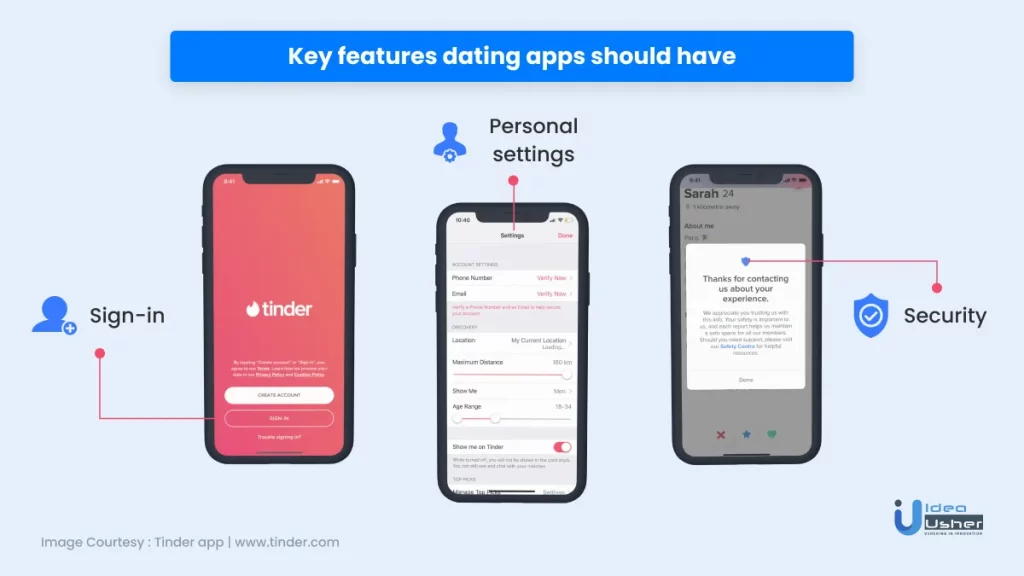
1. Sign-in
The app shouldn’t have a lengthy registration process. The sign-in feature should ease the process of registration for new users.
A user should have access to the following features when using the app for the first time:
- App usage guide
- Sign-up using email/phone
- Sign-up using social media accounts like Facebook, Instagram, or others
The ability to sign-up using social media serves two purposes:
- First, users can quickly and easily register themselves on the app without confirming their email addresses. This ease will generate positive feedback from the users.
- Second, linking social media accounts to the app will help promote the app on the platforms. Thus, it is a win-win situation.
2. Personal settings
Users can choose which information about themselves is made public and which is kept private; they can hide their bio, photos, and even their location from other users if they choose.
An app is incomplete if it doesn’t allow the users to customize their experience. The users should be able to change the settings like audio, categories, preferences, etc. They should also be able to delete their account if they wish to do so.
3. Security
Dating websites and applications are a popular source of harassment. Thus, security becomes a critical issue while developing such an app. The app might verify the user’s identity by checking social media accounts. It should also enable the users to report a profile if it is causing trouble.
Here are some security features to add to a dating mobile app:
3.1 Password recovery feature
This feature allows users to recover their accounts if they forget their passwords. It also helps users who have forgotten their password and need assistance recovering it.
3.2 Two-factor authentication (2FA)
Two-factor authentication adds another layer of security to users’ accounts by requiring them to enter a code sent to their phone after entering their username and password. Thus, it becomes harder for hackers to access users’ accounts and personal information.
3.3 Email verification
If someone tries to register an account using a user’s email address, the user will receive an email from the app asking if they want that person added as a friend or blocked from contacting you.

4. Personal profile
An obvious but essential feature to include in your app is the personal profile feature. The user’s profile should reflect who they are as a person.
For the accounts linked with social media, the profile details can be extracted from the linked social media account. Thus the user doesn’t have to spend time filling in the details.
The personal profile feature should include the following sub-features:
- Ability to view and edit the profile
- Profile verification option
- Popularity record tracking
- App credits (for apps with built-in purchases)
The profile feature helps the users to understand the preferences of other users. Accordingly, they can choose their potential partner.
5. Localization
This feature helps users find their prospective connections in nearby locations. Even in the case of international users, it would be beneficial to know the location of the person they like.
The user can enter their city and country name while building their profile and change it whenever they want. However, it would be better to integrate GPS tracking features to ensure faster and more accurate localization.
6. Direct communication
Once users find a match, they are likely willing to communicate with them personally. Thus, having a direct chatting feature becomes essential.
This feature should include the following sub-features:
- Direct messaging
- Voice/video call
- View profile
- View connections
- Ability to upload audio and media on chat
7. Push notifications
Push notifications alert the users about the new developments on their profiles. These developments can include new messages, new matches, special offers of subscriptions, app updates, etc.
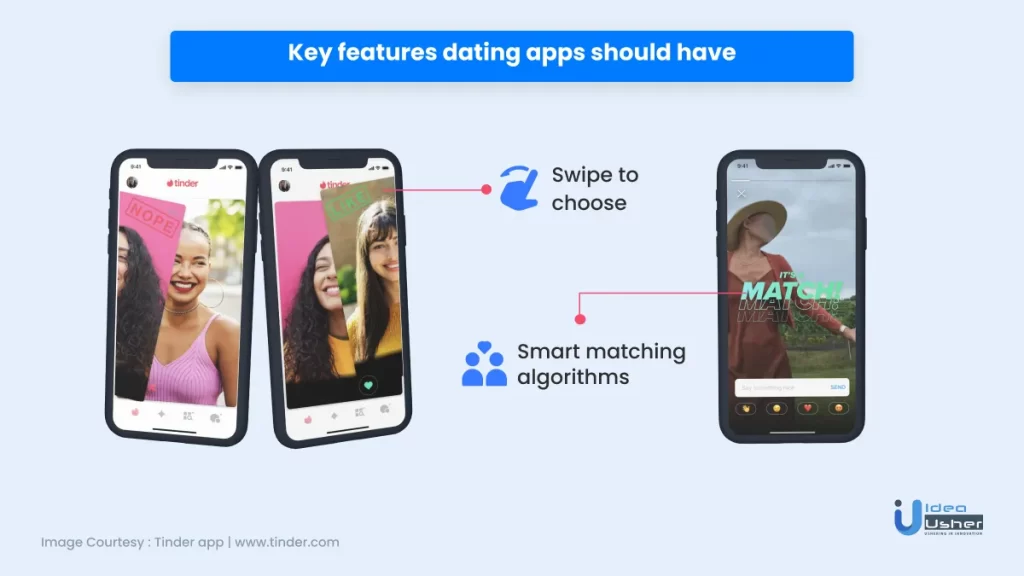
8. Swipe to choose
A traditional dating mobile app like Tinder uses the swipe feature. Having a feature to swipe right for interesting profiles and left for dislikes can be helpful for your app. This feature adds gamification to the app. In simple words, it adds game mechanics to make the app engaging for the users. It also makes the app simple and fun to use.
9. Smart matching algorithms
The app can have intelligent matching algorithms to match a user with another based on their app activity or the information they provide. This feature shows relevant matches to the user without searching for the same.
The matching algorithm can work in any of the following ways
9.1. Location-based matching
This feature involves utilizing the Global Positioning System (GPS) data of the user’s device to determine their physical location. The application then leverages this information to suggest potential matches who are geographically close to the user. This can enhance the chances of connecting individuals who are in close proximity, facilitating real-world interactions and relationships.
9.2. Mathematical matching
In this approach, users are prompted to fill out a comprehensive form detailing various aspects of their interests, preferences, and possibly other relevant information. The app employs mathematical algorithms to analyze and compare these user-provided details. Subsequently, it suggests profiles that align with the information provided, aiming to enhance compatibility and align users with shared interests.
9.3. Behavior-based matching
Behavior-based matching involves the app observing and analyzing the user’s interactions within the platform. It takes into account actions such as profile views, likes, messages sent, and other user activities. By understanding user behavior, the app suggests potential matches that align with the observed patterns, creating connections based on demonstrated preferences and engagement on the platform.
9.4. Machine learning algorithms
This mechanism involves the application employing machine learning algorithms to continuously adapt and improve its matching capabilities. The app learns from the outcomes of previous matches, both successful and unsuccessful, to refine its algorithms. Over time, the system becomes more adept at predicting user preferences, increasing the likelihood of successful matches by dynamically adjusting its matching criteria based on evolving user behavior and feedback.
How to develop a dating app: Step-by-step guide
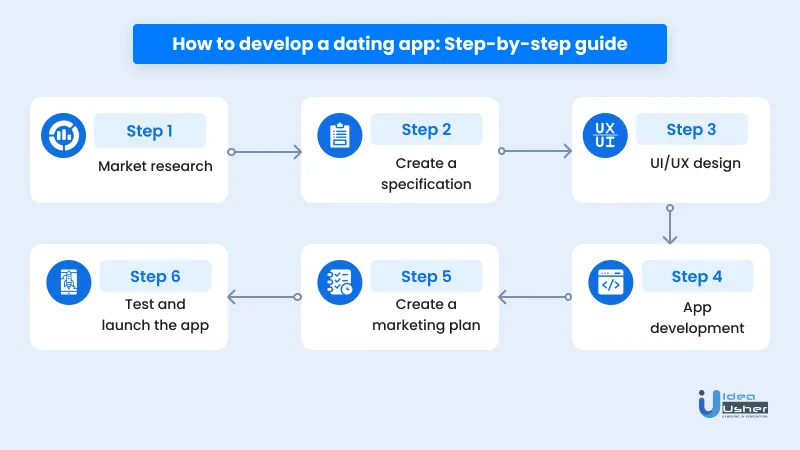
1. Market research
After deciding that you wish to develop a dating mobile app, the first step is to research the market. Market research would enable you to find out what your target audience wants and their pain points. Accordingly, you can create an app that solves their problem and suits their requirements.
Market research would also help you get information about your competitors, their revenue models, and market trends.
2. Create a specification
After researching the market, you need to specify what your app will look like and how it will function. A specification is a document containing all these details.
In the specification document, you need to provide a detailed description of:
- MVP features
- Localization mechanism
- Matching algorithm
- Monetization plan
- Any other detail regarding the way you want your app to function
This document will guide the developers when they start working on developing the app.
3. UI/UX design
The next step is to determine how your app will look and how the users will interact with it. The UI/UX design of the app is crucial because it will decide whether a user will stick to using your app or will move to a competitor’s app.
While working on app design, you should focus on keeping the UI/UX simple and intuitive. Also, the features should align with the overall theme of the app.
4. App development
Development is the most crucial and most time-consuming stage of the entire process. You need to start developing the app and incorporate all the features discussed in the previous section(s).
You can hire a mobile app development company to help you develop a top-class application. They take care of selecting the technology stack and developing the app for you. With its experience and expertise, the app development company will help you take your app to the next level.
5. Create a marketing plan
The app development stage is a long one. Meanwhile, the marketing team should focus on creating a solid marketing strategy to reach the maximum number of users and increase the number of subscribers.
It would be best if you used the time before the app launch to devise the strategy so that the app can reach its target audience as soon as it is launched. A clear and innovative marketing approach can benefit the app’s success.
6. Test and launch the app
Before developing the final app, you should create an MVP of your app to get an idea of what the final app will look like.
Once the full-fledged app is developed, it should go through multiple rounds of testing to ensure that it is error-free. The QA team does the app testing and approves the app after satisfying itself with the app’s quality.
After receiving approval from the QA team, you can launch your app. You can list it on Google Play Store, Apple App Store, or both.
Technology stack required to develop a dating app
Below is the technology stack you need to develop your dating mobile application.
| iOS | Android | Cross-platform | Web-based | |
| Programming Language | Swift UI, WebKit | Kotlin, Java | PHP, JavaScript | JavaScript, Python, PHP, HTML, CSS |
| Frameworks | Swift UI, WebKit | Xamarin, Flutter | React Native, PhoneGap, Ionic | Django, Angular, Ruby on Rails |
| Database | PostgreSQL, MongoDB, MySQL |
| Cloud Storage | Google Cloud, Amazon S3, Heroku, Azure |
| Web Server | Apache, Nginx |
| Payment | Stripe, PayPal, Braintree |
| Authentication | FusionAuth, MessageBird |
| Social Integration | Facebook SDK, Twitter SDK, Instagram SDK, Cloud SDK (Google) |
| Push Notifications | OneSignal, Firebase, UserNotifications |
| Chat and Video | CometChat, Socket.io, RecyclerView, ActionCable |
| Geolocation | Google Maps, Google Location Services, W3C |
| Machine Learning | ApiAI, AmazonML, MonkeyLearn, Rapid API |
| Other Tools | Optimizely, Elasticsearch, Google Analytics, Imgix, Graph API |
Top 10 Dating Apps in the market
Here are the top 10 globally popular dating apps:
1. Match
Match stands out with its versatile approach to finding matches. Users can choose from hand-picked Daily Matches or take charge of their search using extensive search filters. Notably, Match introduces the innovative “Stir” feature, facilitating connections at group events within the user’s city.
2. Tinder
Tinder revolutionized online dating with its iconic swiping function, boasting an impressive 1.6 billion daily swipes. The app takes interaction to the next level with the “Super Like” feature, allowing users to express heightened interest in potential matches.
3. Kippo
Kippo caters specifically to gamers and enthusiasts with geeky hobbies. Its standout features include a virtual arcade space, creating a unique environment for users. Additionally, individuals can showcase their interests in video games, anime, and comics on their profiles.
4. Bumble
Bumble sets itself apart by empowering women to make the first move, promoting a more dynamic and inclusive approach to dating. Beyond traditional dating, Bumble expands its scope by allowing users to search for friends and business connections, adding versatility to its platform.
5. Happn
Happn introduces a captivating twist to online dating by connecting users who have crossed paths in real life. Leveraging GPS, the app notifies users when they cross paths with potential matches, emphasizing spontaneous and chance encounters.
6. Hinge
Hinge adopts a unique approach with features like “Prompts,” short questions that inject flair and humor into user profiles. The “Standouts” feature curates a list of the most compatible matches, enhancing the overall matchmaking experience.
7. OkCupid
OkCupid stands out with its comprehensive features, including a guided communication system and an extensive questionnaire. These elements contribute to a more nuanced matchmaking process, prioritizing compatibility.
8. eHarmony
Renowned for its detailed compatibility matching system, eHarmony goes beyond surface-level preferences to help users find their ideal match based on deeper dimensions of compatibility.
9. Facebook Dating
Facebook Dating recommends matches based on shared interests, utilizing Facebook data to find commonalities. One of its most unique features is the “Secret Crush” function, enabling users to select up to nine Facebook friends or Instagram followers as potential secret interests.
10. POF (Plenty of Fish)
POF differentiates itself by allowing users to message each other without needing to match or subscribe. The app also features a live-streaming option, fostering a sense of community among its users. POF Premium offers additional features like access to new users, extended profiles, and the ability to see if you’ve messaged someone before. The platform places a stronger focus on messaging and compatibility than on photos, encouraging users to get to know each other before deciding whether to swipe left or right. Recent additions include a compatibility quiz and Cue Me!, a game featuring a series of quirky questions designed to reveal unique aspects of users.
How to use AI in dating apps?
A dating platform is no longer restricted to the old and traditional working. With innovations like AI and ML, apps have advanced and have become more competent. You can integrate AI into these apps in a lot of ways. The use of AI can be varied, and you need to decide the purpose of integrating AI into your app. Some of the uses are given below.
1. Relevant matches
As discussed earlier, using AI and ML can help suggest relevant profiles to the users based on their in-app behavior and their profile details. Many apps set up their algorithm to suggest profiles based on music taste, food preferences, personality traits, attitudes, beliefs, etc.
2. Making people meet offline
Although these apps are meant for online dating, the end purpose of the users (mostly) is to meet the other person offline. The users can often forget this purpose. Thus, the apps can use AI to encourage people to meet offline.
For example, eHarmony plans to include an AI feature that encourages users to suggest meeting offline after interacting online for a while.
3. Minimizing unsolicited content
AI can also help in improving the security of the app. With millions of people using the app, there may be cases of abusive or unwanted content being shared. You can implement AI technology to reduce these instances.
For example, Bumble has a safety feature that uses AI to detect potentially unwanted content with 98% accuracy and warns the user about the same. It gives the user the option to view or ignore the content.
4. Securing online dating space
In addition to filtering spam and abusive and unwanted content, apps can also use AI to detect and ban scammers. Every online platform has a few users who create fake profiles to defraud and scam people. AI can detect these profiles and ban their accounts to ensure a safer and more reliable user experience.
5. DNA matching
Apps can also predict the chemistry between two people based on their DNA profiles. For example, DNA Romance uses AI to suggest the most compatible partners based on users’ DNA samples. This feature is essentially helpful for those who believe in looking for a partner from a scientific perspective.
How to make money from dating apps?
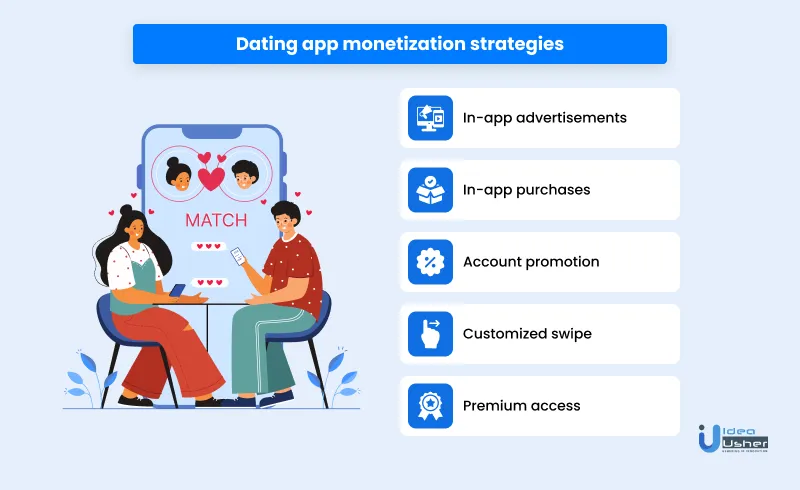
After discussing the procedure of dating mobile app development, it would be pertinent to discuss how you can earn money from these apps. Numerous strategies can help you make money from such apps. Some of them are listed below:
1. In-app advertisements
Dating mobile apps serve as an ideal platform for advertisers as these apps already have information about the user’s likes, dislikes, and preferences. They can use this information to show relevant ads to the app users.
2. In-app purchases
You can include certain elements and widgets in your app that the users can purchase after paying a certain amount of money. These elements can consist of customized stickers for text messages, filters for video calls, etc.
3. Account promotion
You can charge a certain amount from the users to upgrade their profile and make it rank higher for a certain amount of time.
4. Customized swipe
The customized swipe feature uses machine learning technology to change the order of profile photos based on the user seeing them. The users can unlock this feature by paying a certain fee.
5. Premium access
Your app can work on a freemium business model. You can provide certain features for free and ask the users to pay to unlock the premium features. The premium features may include ad-free use, unlimited swipes, etc.
Future of dating apps
The future of dating apps will revolve around heightened interactivity and personalized experiences, prioritizing quality connections over sheer quantity. Here are some of the emerging trends:
1. Elevated Social Interactions
Departing from conventional swiping, dating apps are embracing more interactive features. Bumble’s “Night In” trivia and Tinder’s “Swipe Night” exemplify this shift, allowing users to engage in shared activities and building meaningful connections.
2. Integration of Video and Audio Features
The integration of video and audio functionalities promises a novel dimension to online interactions, potentially deepening connections as users spend more meaningful time on these platforms.
3. Enhanced AI Capabilities
Advancements in machine learning are steering dating apps toward more refined matchmaking. AI algorithms may soon consider user behaviors within the app, including browsing patterns, chat content, and response times, delivering matches aligned with actual actions rather than stated preferences.
4. Rise of Virtual Reality (VR) Dating
Virtual dating is here to stay, with VR dating emerging as a promising prospect. This could involve immersive VR dates and even the integration of digital assistants to facilitate conversations.
5. Focus on Mental Health and Vulnerability
Forecasts by dating experts underscore a sustained emphasis on mental health and vulnerability within dating apps. Platforms are expected to increasingly address the emotional well-being of users.
6. Potential Integration of DNA Testing
Speculations about the future of online dating hint at the possibility of DNA tests influencing matchmaking, predicting chemistry and compatibility.
Contact Idea Usher to develop your dating app
Developing a dating mobile app may seem like an easy business opportunity, but it is not something one should take lightly. It is a lucrative business idea and requires expert guidance to succeed. You need to pay attention to every small detail while developing such an app. Hiring a mobile app development company can ease your burden.
Idea Usher has been in the business of providing app development services for many years. We have a 100% product delivery success rate and a track record of client satisfaction. Having worked on more than 200 projects, we strive to serve our clients with excellence.
Get in touch with us, and get your dating app developed now.
Final Thoughts
Online dating has become a common phenomenon these days. The dependency on technology for almost everything has given rise to mobile apps for every activity. The same is true for dating as well. According to Statista, the number of users in the online dating segment is expected to reach 501.7 million by 2026.
With a rise in the popularity of online dating and the opportunities this sector brings, one cannot overlook the business opportunity of developing a dating mobile application. With proper market research, interesting app features, appealing UI/UX design, and a good development team, your app business is sure to succeed.
Work with Ex-MAANG developers to build next-gen apps schedule your consultation now
Frequently asked questions
Here are some interesting FAQs on how to create a dating app.
Q. Which are the latest technologies in dating mobile app development?
You can include the following technologies in the app to make it stand out:
- Database and cloud storage
- Machine learning and AI
- Authentication combined with social integration
- Payment integration
- Video and voice chat APIs
Q. How much time does it take to develop a dating mobile app?
The time to develop a mobile app varies depending on the app’s complexity. However, the average time needed to develop the app is given below:
- Onboarding: 95+ hours
- Personal profile: 160+ hours
- Matching: 80+ hours
- Chatting: 130+ hours
- Security issues: around 55 hours
- Push notifications: 40+ hours
- Settings: 60+ hours
Q. What factors affect the cost of developing a dating mobile app?
The cost of developing a dating mobile app varies based on several factors, including:
- App features
- App functionality
- Turnover time
- Resources and tools used
- App platform
